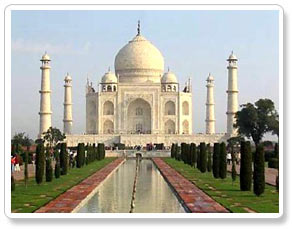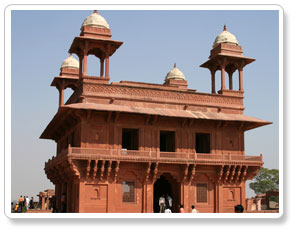
You Are Here :: Golden Triangle Tours India :: Tourist Places Guide :: Agra Travel Trip
Agra Travel Trip
 Agra, the city of the Taj Mahal and once the capital of the Mughal empire, has several monuments and world heritage sites which display the splend our of Mughal architecture. It was here that Babar, the founder of the dynasty, had the first formal Persian garden laid out on the banks of the river Yamuna. Akbar, his grandson, raised the towering ramparts of the great Red Fort, with in whose walls Jahangir built rose-red palaces, courts and gardens, and which Shahajahan embellished with marble mosques, palaces and pavilions of gem-inlaid white marble.
Agra, the city of the Taj Mahal and once the capital of the Mughal empire, has several monuments and world heritage sites which display the splend our of Mughal architecture. It was here that Babar, the founder of the dynasty, had the first formal Persian garden laid out on the banks of the river Yamuna. Akbar, his grandson, raised the towering ramparts of the great Red Fort, with in whose walls Jahangir built rose-red palaces, courts and gardens, and which Shahajahan embellished with marble mosques, palaces and pavilions of gem-inlaid white marble.Agra is mentioned in the ancient epic Mahabharata as Agraban, the sister city of the more prominent Mathura. Agra was established in 1475 by Badal Singh and came into its own when Sikander Lodhi of the Lodhi dynasty chose it for his capital because of its proximity to the Yamuna. Babur defeated the Lodhis to capture not only Agra but also to lay the foundation of the Mughal empire. In the mid-16th and earlier 17th centuries, Agra witnessed afrenzied building activity and it was during this time that the symbol oflove, the Taj Mahal, was built. The buildings made during this era were purely in the contemporary Mughal style and of very high quality. Besides the monuments, Agra is worth a visit for the master pieces of craftsmen recreating the glory of the Mughal period and for the Mughlai cuisine, the aroma of which fills the narrow lanes of Agra.
Prime Attractions Of Agra :
» Agra Fort - The Agra Fort was built between1565 and 1571 AD, the fort retains the irregular outline of the demolishedmud wall fort of the Lodhi’s. The magnificent towers, bastions,ramparts, and gateways,symbolize the stature and power of Akbar. As one enters from the Amar Singh gate, the first monument to be seen is
»The Jahangiri Mahal, which was built by Akbar as the women’s quarters andis the only building that survives among his original palace buildings. This elegant , double storied palace reflects a strong Hindu influence with protruding balconies and domed chhatries. The Jahangiri Mahal is a Transoxanion and Gujarat-Malwa-Rajasthan styles. Khass Mahal, is built entirely of marble and demonstrates distinctive Islamic- Persian features. This palace was considered to be as ShahJahan’s sleeping quarters. The Mahal provides the most successful example of paintings on a white marble surface. This palace brings the later Mughal architecture to age. The Sheesh Mahal, is a creation of myriad glass pieces and central fountain. It is believed to have been the harem dressing room and it's walls are inlaid withtiny mirrors which are the best specimens of glass mosaic decoration in India. The Musamman Burj, is a beautiful octagonal tower with an open pavilion. The inlay work here is exquisite, especially above the pillars.This was where Shah Jahan lay on his death bed, gazing at the Taj. Diwan-i-Khaas, this was the hall of private audience. The marble pillars are inlayed with semi-precious stones in beautiful floral patterns. Diwan-i-Am, who searches are covered with white lime polished to a smooth finish, has triple arched royal canopy with lavish pietra dura ornamentation. The Moti Masjid,is a white mosque known for it's sheer grandeur and perfect proportion.
» Jama Masjid - Builtby Shah Jahan in 1648, the main gate of this mosque has inscription written on it that it was built by Jahanara Begum. She was the favorite daughter of Shah Jahan and was imprisoned with him. The absence of minarets and the shape of the dome gives it a distinguished character.
» Taj Mahal - Taj Mahal, the most elaborate monument ever built for love is a mesmerizing monument of pristine white marble. The structure is of pure white marble which gives a silver radience in the soft moonlight, at dawn one can see it change colour to a shell - pink glow, and at the close of the day, takes onthe tawny, fiery hue of the majestic sun. This seventh wonder of the world was built by Shahjahan in the memory of his beloved wife, Mumtaz Mahal, the lady of the Taj, who died giving birth to their 14th child. This great monument was Arjumand Banu's last wish to her husband. The construction of the monument started in 1631 and ended by 1653. About 20,000 people were recruited to give shape to this poetry in marble. The main architect, Isa Khan, came from the far off country of Iran. Shahjahan's intention to build a second Taj of Black marble as his own tomb a negative image of the white Taj, was shattered when he was imprisoned in the Agra Fort by his son Aurangazeb. The last days of Emperor Shahjahan was spent in the Agra Fort from where he could see the Taj Mahal, his wife's final resting place a cross the river. The Taj is a symbol of eternal love built in the loving memory of Mumtaz by the heart-broken Shahjahan who was also burried and reunited with his beloved wife.
 » Fatehpur Sikri - Perched a top arocky ridge 37 km west of Agra, Fatehpur Sikri came into being four centuries ago when the Emperor Akbar, not yet 28 years old, created the first planned city in Indo-Islamic style. The city was actualised with great energy, but was completely abandoned a little more than a decade later.
» Fatehpur Sikri - Perched a top arocky ridge 37 km west of Agra, Fatehpur Sikri came into being four centuries ago when the Emperor Akbar, not yet 28 years old, created the first planned city in Indo-Islamic style. The city was actualised with great energy, but was completely abandoned a little more than a decade later.In 1568, Akbar was secure and powerful but he had no son and heir. His search for blessing for the birth of a successor brought him to the Sufimystic Shaikh Salim Chisti, who lived in Sikri village. The saint prophesied the birth of three sons and soon after was born Prince Salim, later to become Emperor Jahangir. In gratitude for the blessing Akbar decided to create imperial residences in Sikri, which would function as a joint capital with Agra. As a mark of his faith and his recent victories, he named his new city Fatehpur Sikri. Akbar was a keen builder and the plan of Fatehpur Sikri reveals an architectural mastermind at work. Research has proved that it was planned on a definite mathematical grid.
The siting of the Jama Masjid marked the actual beginning of the city which came up around it. The palace courts were laid out parallel to the cardinally aligned mosque and the sequential order of the palaces were emphasised by change in level. The most public space was at the lowest level, while the royal harem was at the highest.

 Attraction in Agra
Attraction in Agra Attraction in Jaipur
Attraction in Jaipur  Attraction in Delhi
Attraction in Delhi